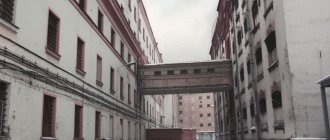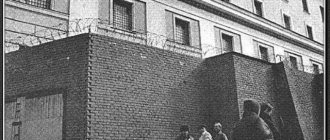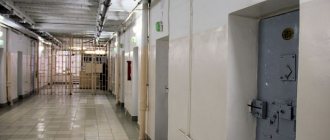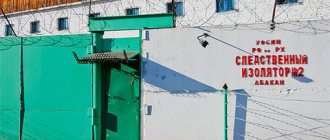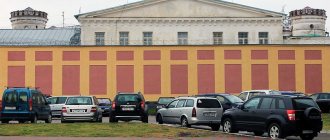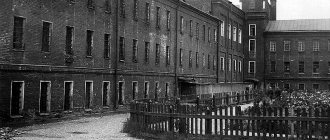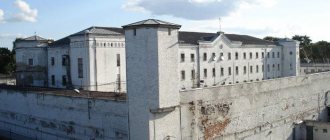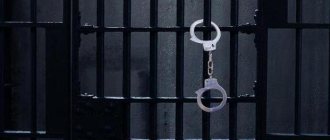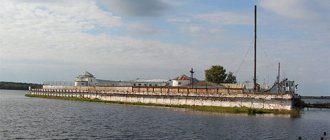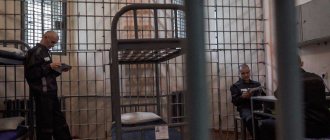Contact information of pre-trial detention center 1 - Sailor's Silence: Duty department of PKU SIZO-1 UFSIN of Russia in Moscow tel.:8 Helpline PKU SIZO-1 UFSIN of Russia in Moscow tel.
The official name of pre-trial detention center 1 - Matrosskaya Tishina: Pre-trial detention center No. 1 of the Federal Penitentiary Service in Moscow. Address of pre-trial detention center 1 - Sailor's Silence: 107099, Moscow, st. Matrosskaya Tishina, building 18 Head of pre-trial detention center 1 - Sailor's silence: Klochek Vladimir Leonidovich Official website of pre-trial detention center 1 - Sailor's silence: https://www.pre-trial detention center-matrosskaya.rf
Schedule for the reception of citizens in pre-trial detention center 1 - Sailor's Silence:
Reception of citizens by the management staff of the institution is carried out from 11:00 to 13:00 (medical workers every Monday from 14:00 to 16:00)
| Monday (from 14:00 to 16:00) | Head of the branch “Medical unit No. 1” of the Federal Medical Institution of Medical Unit 77 of the Federal Penitentiary Service of Russia in Moscow, major of internal service Roracheva Larisa Yurievna (medical specialist) |
| Tuesday | Deputy Head of PKU SIZO-1 of the Federal Penitentiary Service of Russia for Moscow (oversees the rear service), Colonel of the Internal Service Nechaev Mikhail Valerievich |
| Wednesday | Deputy Head of PKU SIZO-1 Federal Penitentiary Service of Russia for Moscow (supervises security and operational services), lieutenant colonel of internal service Gadzaonov Alan Georgievich |
| Thursday | Head of PKU SIZO-1 Federal Penitentiary Service of Russia in Moscow, Colonel of Internal Service Klochek Vladimir Leonidovich |
| Friday | Deputy Head of PKU SIZO-1 of the Federal Penitentiary Service of Russia in Moscow (oversee personnel and educational work), lieutenant colonel of the internal service Perederin Igor Yurievich Reception of citizens on the issue of drawing up powers of attorney (reception, issuance of completed documents, consultations). |
| Saturday | Responsible from management |
| Sunday | Responsible from management |
Reception of citizens is carried out daily from 11:00 - 13:00.
Description of the pre-trial detention center
Location: Moscow, st. Matrosskaya Tishina, 18.
Postcode: 107076.
E-mail address
The pre-trial detention center does not have a specific regime. It differs from a colony in that it houses suspects of any crimes, and not convicts whose crimes have already been proven and for whom a prison term has been imposed.
Telephones and faxes with the full names of contact persons for these telephones:
| Supervisor | Days of the week | Time of receipt |
| Chief Podrez Anton Stanislavovich | telephone | Thu from 09-30 to 16-30 |
| fax:+7 | Fri from 09-30 to 15-30 | |
| Deputy Chief of Security and Regime Sergey Pavlovich Kozlov | telephone | Mon from 09-30 to 16-30 |
| fax:+7 | Wed from 09-30 to 16-30 | |
| Deputy Head for General Issues Oleg Midekhatovich Gafarov | telephone | Tue from 09-30 to 16-30 |
The detention center has its own page in the GUFSIN https://www.77.fsin.su/structure/sizo_1/ and an official website - https://sizo-1.ru/content/page2/, as well as a group on the social network Vkontakte https http://vk.com/sizo_matrosska.
Map - how to get there
Visiting room opening hours
The schedule for receiving packages and working hours of visiting rooms is presented in the table:
| Day of the week | Accepting applications | Opening hours for visiting rooms |
| Monday | 09:00 – 16:00 | 09:30 – 17:30 |
| Tuesday | 09:00 – 16:00 | 09:30 – 17:30 |
| Wednesday | 09:00 – 16:00 | 09:30 – 17:30 |
| Thursday | 09:00 – 16:00 | 09:30 – 17:30 |
| Friday | 09:00 – 15:00 | 09:30 – 17:30 |
| Saturday | 09:00 – 16:00 | 09:30 – 17:30 |
| Sunday | 09:00 – 16:00 | 09:30 – 17:30 |
Lunch break from 13-00 to 13-45.
Infrastructure
The Matrosskaya Tishina pre-trial detention center is located in the developed Sokolniki district of Moscow .
It is surrounded by simple houses and shopping complexes; huge crowds of people pass by the detention center every day, and not every one of them knows that behind the yellow walls of a tall building there is a place of deprivation of liberty. In appearance, the pre-trial detention center is no different from other Moscow buildings. It is not surrounded by a high fence with barbed wire, like most other MLS in Russia. The building of the pre-trial detention center is located in the shape of a trapezoid and, of course, is a barrier (fence) of the pre-trial detention center.
In the center of the emerging well on the territory of the detention center there is the Prison Church of the Icon of the Mother of God “JOY OF ALL WHO SORRY”, a hospital for the treatment of suspects and convicts with serious illnesses, as well as a local stall where convicts can purchase the necessary food products and a headquarters for employees.
This is the street, this is the house
Pre-trial detention center No. 1, like a number of similar places of deprivation of liberty, has an unofficial name - “Matrosskaya Tishina”. Despite the gloomy connotation, it has nothing to do with the sailors who are forever “quiet” within the walls of this institution. And it was received in honor of the street where the building of the pre-trial detention center is located.
Photo of the “Matrosskaya Tishina” pre-trial detention center from the street, Andrey Stenin / © “RIA Novosti”
But the street itself was named that way for a reason. Back in the reign of Peter I, by sovereign decree, a sailing factory with an adjacent sailor settlement was located in this area. The factory subsequently moved closer to the water - to Novgorod. But the sailors remained. True, now only elderly veterans who lost their health and youth in battle and were left to live out their days on government support - in the building of an almshouse erected on the site of the former settlement.
Since the establishment was inhabited by naval personnel, and it was located far from the noisy city center, and the authorities demanded that a regime of silence be observed, prohibiting even the passage of horse-drawn vehicles in the vicinity of the almshouse, as a result, the area was popularly dubbed “Sailor’s Silence.” And later the street received this name.
Photo of the institution and cameras inside
Next in the photo you can see what the prison is like:
What crimes do they get here for and who is imprisoned?
The Matrosskaya Tishina pre-trial detention center houses accused and suspects in various categories of crimes. As a rule, prisoners whose cases are being investigated by the federal security service and the Ministry of Internal Affairs are kept here. Currently, about 1,700 people are being held here .
Most of the suspects are rich and quite famous people. In this regard, the pre-trial detention center has a lot of judicial scandals and proceedings - employees of this MLS often extort money from the accused (https://rapsinews.ru/trend/sizo_11062015/).
Local celebrities
Until the early 90s, no one even thought of keeping a census of the “celebrities” held in the pre-trial detention center. But the situation changed when, after the events of August 1991, the entire top of the State Committee for the State of Emergency (GKChP) came to the pre-trial detention center, which included the following high-ranking persons:
- Vice President of the USSR Gennady Yanaev;
- Chairman of the KGB of the USSR Vladimir Kryuchkov;
- Defense Minister Dmitry Yazov;
- Prime Minister Valentin Pavlov.
After such notable “nobles” “visited” the institution, “Matrosskaya Tishina” gained its first fame among the general public. Subsequently, the lists of “distinguished guests” were supplemented by other people, from crime bosses to political figures. Among them:
- thief in law Vyacheslav Ivankov, nicknamed Yaponchik;
- killer Alexander Solonik, nicknamed Macedonian, famous for a number of high-profile murders;
- Oleg Kostarev, who staged a terrorist attack on the Cherkizovsky market in 2006 (the explosion killed 14 people, including two children, and injured more than 60);
- organizer of the MMM financial pyramid Sergei Mavrodi;
- the notorious owner of Mirax Group Sergei Polonsky;
- Mayor of Yaroslavl Evgeny Urlashov, convicted of attempting to receive a bribe of 17 million rubles;
- tax-hiding oligarch and oil co-owner Mikhail Khodorkovsky.
In 2022, the name of the Russian public figure and blogger Alexei Navalny, who violated the terms of his probation in a fraud case, was added to the “honorable collection” of the Matrosskaya Tishina pre-trial detention center.
Conditions of detention
There are currently many more prisoners in Matrosskaya Tishina than expected. The limit is 800 people. In this regard, prisoners often receive complaints about accommodation . So, for example, in one cell of the first building, where there are 10 beds, there are 18 prisoners, although the cell is generally designed for 6 beds. The prisoners independently constructed sleeping places for themselves from ropes (https://www.mk.ru/social/2017/12/13/ad-v-matrosskoy-tishine-sosedstvuet-s-pyatizvezdochnym-raem-dlya-bogatykh.html).
In addition to overcrowding, there are many other obvious problems. Bed linen is changed very rarely, and cleaning is also done infrequently. You can guess that with such a large number of people in one cell there is much more dirt.
Unlike other Russian pre-trial detention centers, there are no refrigerators in the cells of Matrosskaya Tishina . Due to this, prisoners have to breathe in the putrid smell of food in their cells.
But not every building has such a routine. In the second wing of the building, the cells are filled with 3-4 people. Unlike the previous building, renovation work is underway here, and the building looks very clean inside. Cleaning is done quite often. The cells have a refrigerator, TV, table, washbasin and even a shower room with a toilet, and shelves for personal belongings.
And there are cameras that are more like cozy rooms in a house . They have been beautifully renovated, have an excellent toilet and bathroom, many different shelves for kitchen items, a refrigerator, a wardrobe, two large windows, and a TV. After reading this, it’s hard to believe that we are talking about a place of deprivation of liberty, but this is really so. In one of these cells was the swindler Dionisy Zolotov.
The reason for the uneven distribution lies in the status of each suspect. In the first building there are foreigners, courtesans, petty thieves and others. In the second - businessmen, deputies and other people caught in any crimes.
In Matrosskaya Tishina, prisoners can wear any clothes that are comfortable for them. Despite the fact that there is a hospital on the territory of the pre-trial detention center, patients are not examined so often due to their number. Doctors simply do not have time to see everyone at once. For this reason, many prisoners get very sick. There is a constant epidemic of lice in the pre-trial detention center .
Schedule
The daily routine of the sailor's silence is not much different from other pre-trial detention centers. Let's look at it in the table:
| Climb | 6:00 |
| Morning toilet and cleaning of beds | 6:00-6:30 |
| Cleaning the cells | 6:30-7:00 |
| Breakfast | 7:00-8:00 |
| Morning check, medical examination | 8:00-9:30 |
| Personal time | 9:30-12:00 |
| Walk | 12:00-13:00 |
| Dinner | 13:00-14:00 |
| Walk and personal time | 14:00-17:00 |
| Dinner | 17:00-18:00 |
| Cleaning the cells | 18:00-19:00 |
| Personal time, watching TV | 19:00-20:00 |
| Evening check | 20:00-21:30 |
| Preparation for sleep | 21:30-22:00 |
| Dream | 22:00 |
Nutrition
In Matrosskaya Tishina, food is brought to prisoners in their cells . There are three meals a day: breakfast, lunch and dinner. The prisoners are fed very well. Back in 2013, Vladimir Zhirinovsky came to this pre-trial detention center to familiarize himself with the conditions of detention. According to him, the food is fully consistent with the life of the country, perhaps even better.
- For breakfast, convicts are fed porridge: oatmeal, rice or millet. They give a piece of white bread with butter, tea or cocoa, sometimes yogurt or cottage cheese.
- For lunch , as expected, the first course can be cabbage soup, borscht, rassolnik, solyanka and pea soup. And the second course is meat or fish with any type of side dish (buckwheat, rice, mashed potatoes). Compote or juice with a piece of bread.
- Dinner can consist of dumplings, buckwheat with fish, cutlet, etc.
Just like in any other MLS, it is possible to have your own food. Relatives can bring it, or you can order it from a local stall.
Work and study
In pre-trial detention centers, including Matrosskaya Tishina, prisoners cannot work and study remotely . They can only learn any science on their own, using books and TV.
Religious issues
In 2022, a church was built on the territory of the pre-trial detention center, where the senior priest, Archpriest Sergius Kiselev, constantly comes. He often meets with prisoners, teaches them how to pray correctly and is a spiritual mentor. In Matrosskaya Tishina there are a lot of believers who have crosses, icons, the Bible and other religious objects that are not prohibited in the MLS. On weekends, a service is held in the temple, which prisoners can attend.
Entertainment and relaxation
There are televisions in the prisoners' cells, which they can watch in their free personal time. The television program is selected by the management of the pre-trial detention center itself . There is also a library with a large selection of books.
In one of the buildings there is a club where various kinds of events are held for prisoners. Holidays are celebrated here, prisoners themselves can perform on stage and show their creative abilities. In the cell, prisoners constantly play cards until the guards see it.
Every day, prisoners are taken for a walk on the roof in special cells where there is a view of the sky (instead of a ceiling there is a grill). Here they can breathe fresh air and chat with each other.
Dates and visits
Visits with relatives are allowed in sailor silence . There are no specific restrictions on the number of visits. From Monday to Sunday, the time for short-term visits is from 9:30 to 17:30.
Transfer of products and things
The transfer of food, belongings and medicines is carried out daily from 9:30-16:30. The list of prohibited and permitted products can be viewed on the official website listed above.
So, for example, it is allowed to bring :
- bread;
- salo;
- cheeses;
- oil;
- cold smoked fish, etc.
Forbidden:
- cereals;
- raw meat and fish;
- greenery;
- cucumbers;
- tomatoes, etc.
All permitted products and items will be confiscated by the detention center staff . If you intentionally carry (transfer) a prohibited item to a prisoner, the relative who brought the parcel will be subject to administrative or criminal punishment.
Punishment cell
Like any other place of deprivation of liberty, there is a punishment cell where prisoners are sent for bad behavior and non-compliance with the laws of the prison. Unlike prisons and colonies, the punishment cell in Matrosskaya Tishina is a rather cozy cell, with a bed, a table and a shelf for personal belongings. A prisoner can spend up to 15 days in a punishment cell. But, of course, here, as elsewhere, the guards do not give rest to the violent prisoners of the punishment cell - they constantly “remind themselves.”
Schedule
In the “Matrosskaya Tishina” pre-trial detention center, the daily schedule for the people kept within its walls is subject to a strict routine. Wake-up is at 6:00. Lights out at 22:00. The lighting in the cells does not turn off even at night. There is a daily walk lasting one hour. Washing in the shower - once a week, 15 minutes are allotted for all procedures, during which hot water is supplied.
Cell in the “Matrosskaya Tishina” pre-trial detention center / Photo: Gennady Cherkasov, “”
Leisure activities include watching TV during the designated hours. The list of permitted programs is determined by the management of the pre-trial detention center. The institution also has a library, which, however, does not spoil you with a variety of literature. And a club that is not particularly popular, where prisoners can express themselves creatively.
Features of the prison regime
As already written above, a clear feature of the prison regime of this pre-trial detention center is the uneven distribution of prisoners among cells . Some live here in comfortable conditions, like at home, while others are crammed into a narrow and dirty cell.
In connection with the existence of VIP cameras, a big scandal occurred in December 2022. The POC commission, arriving in sailor's silence, saw a huge difference between the contents of various layers of prisoners and came to the conclusion that known scammers were kept in very good conditions and even had access to communications. The result was that members of the POC commission were simply prohibited from inspecting this prison.
Scandalous fame
There was enough of “Matrosskaya Tishina” and all sorts of scandals. There were rumors about the presence in the pre-trial detention center of special “apartments” for wealthy “clients”. There, in contrast to standard cells, the conditions of detention were not much different from hotel ones: no more than three people in a room, a TV, a refrigerator and other amenities of civilization. Subsequently, the information was confirmed, which led to the dismissal of a number of senior employees.
On the territory of the pre-trial detention center, prisoners have repeatedly died for various reasons - as a result of beatings from both cellmates and pre-trial detention center employees, from hunger, from drug overdose. There were also cases of suicide.
Story
The Sailor's Silence building was built back in 1775 and was originally intended for the “insolent.” After which, in 1870, the house was renamed the Moscow Correctional Prison, designed for 300 men and 150 women.
In 1912, the building underwent restoration ; several prison buildings were built according to the design of the famous architect B.A. Alberti. In 1918, the profile of the building changed slightly; a reformatory for juvenile convicts appeared on the basis of the prison. Afterwards - Kozhevnicheskaya correctional colony, then prison No. 14 of the Ministry of Internal Affairs of Moscow. region, since 1956 prison, then only pre-trial detention center No. 1 of the Moscow Central Internal Affairs Directorate.
Initially, the building consisted of only 2 security buildings, which accommodated about 2,000 prisoners. in 1949, in the post-war period, the number of buildings increased to 3. Moreover, the third building housed a special prison for Nazi criminals and traitors to the Motherland. From 1953 -1957, juvenile delinquents were kept here, and then the corus was converted into a tuberculosis department.
Why is it called that?
The formation of the name also has an interesting history . In Sokolniki, by decree of Peter 1, a sail factory and a sailors' settlement were built, where sailors lived. When Moscow became a “port of the seas” in the 20th century, the Catherine Sailors’ Almshouse for naval veterans was opened in the building. It was strictly forbidden to make noise or even ride carriages near her. Afterwards this building became known as “Matrosskaya Tishina”.
There are several scary prisons on the territory of the Russian Federation, among them the Black Dolphin, the Black Golden Eagle, the Polar Owl, the White Swan, the Vologda Pyatak, the Vladimir Central, Snezhinka, as well as Lefortovo and Butyrskaya, which you can learn about from separate materials on our portal.
The most famous prisoners and escapes
Over the entire history of Sailor's Silence, a huge number of famous prisoners have been in the pre-trial detention center. Let's look at the stories of some of them:
- Alexander Solonik, nicknamed “Valeryanych,” is a Russian killer with dozens of murders to his name. He was caught several times and put in prison, but he escaped again, changing his first and last name. He was killed, but there was talk that the killer remained alive for a very long time. Many different documentaries have been filmed and a huge number of articles have been written on this topic.
- Valentin Kovalev is the Minister of Justice of the Russian Federation. He was placed in a pre-trial detention center for theft of 9 million rubles.
- Platon Lebedev is the former chairman of the board of directors of Group MENATEP and co-founder of Menatep Bank. He was accused of theft and tax evasion, but was released and resumed business activities.
- Yuri Budanov is a Russian military man who was stripped of his military rank in 2003 for being accused of kidnapping, rape and murder and the murder of 18-year-old Elza Kungaeva.
In the history of this detention center there are several successful escape attempts:
- The first of them was committed in June 1995, when Alexander Solonik, together with his guard Menshikov, escaped through the roof by climbing a rope. Before him, no criminal had ever escaped.
- The second escape occurred on May 2, 2004, by prisoner Sergei Ershov. He was a drug addict and could not live without a dose of heroin. Having dismantled the brickwork, he overcame the fence and escaped, despite numerous wounds. 20 hours later he was found and brought back.
- The third serious escape was committed in 2013 on May 7 by Oleg Topalov, accused of double murder and theft of cash and jewelry.
With the help of one of the pre-trial detention center employees, the prisoner managed to leave the cell and get to the roof. There, the guard prepared him climbing equipment, with the help of which he successfully descended and left the detention center. A search was announced immediately, and the next day the fugitive was found in Izmailovsky Park in Moscow. Interestingly, he was later acquitted and released.
An interesting incident in the pre-trial detention center occurred in March 2003, when one of the prisoners, having lost a large amount of money to his cellmates at cards, hid for a long time in a pile of construction waste next to the medical building. He was afraid of persecution and torment for losing, so he ran away. There he ate waste from garbage cans.
Application for a date: how to draw up, sample and other documents
A visit to a prisoner is granted on the basis of an application, which is drawn up according to the general rules of business proceedings and submitted to:
- investigator in a criminal case at the investigation stage and before the case is transferred to court. Be prepared that the investigator will refuse you and avoid meeting with you, since this is usually not beneficial for him;
- judges (when the case has already been brought to court) or
- the head of a specific pre-trial detention center (if the sentence has already entered into force, but the convict has not yet been transferred to a colony).
In order to write it, you will need to physically come to the investigator, judge or pre-trial detention center and submit it in person.
If the investigator refuses you, then you need to receive a written refusal and contact a higher authority with it.
A sample of such a statement looks like this:
Sample application for a visit to a pre-trial detention center
The application form can be downloaded here>>> .
Based on the application, permission to visit is issued, which looks like this:
Please note that you will also need a document proving your identity (usually a passport and a marriage certificate).
Mentions in popular culture
A lot of books and songs have been written about Sailor's Silence . People from prison, as well as ordinary witnesses to the events taking place in it, found it interesting to write various works about this detention center. Among them: Boris Sedov, Valery Karyshev, Alexander Galich and Ivan Mazutin, each of whom wrote a book called “Sailor’s Silence”.
Evgeny Kemerovsky, Alexander Marshal and many others wrote songs about this detention center.
Matrosskaya Tishina is a special pre-trial detention center . It is very difficult for some people in it: living in a cell with a large number of “neighbors”, sleeping on torn and old sheets and breathing the putrid smell of rotten food. And for some, it’s very easy and comfortable being in the VIP chambers. But nevertheless, no one dreams of getting there, even despite the “chic” conditions.
